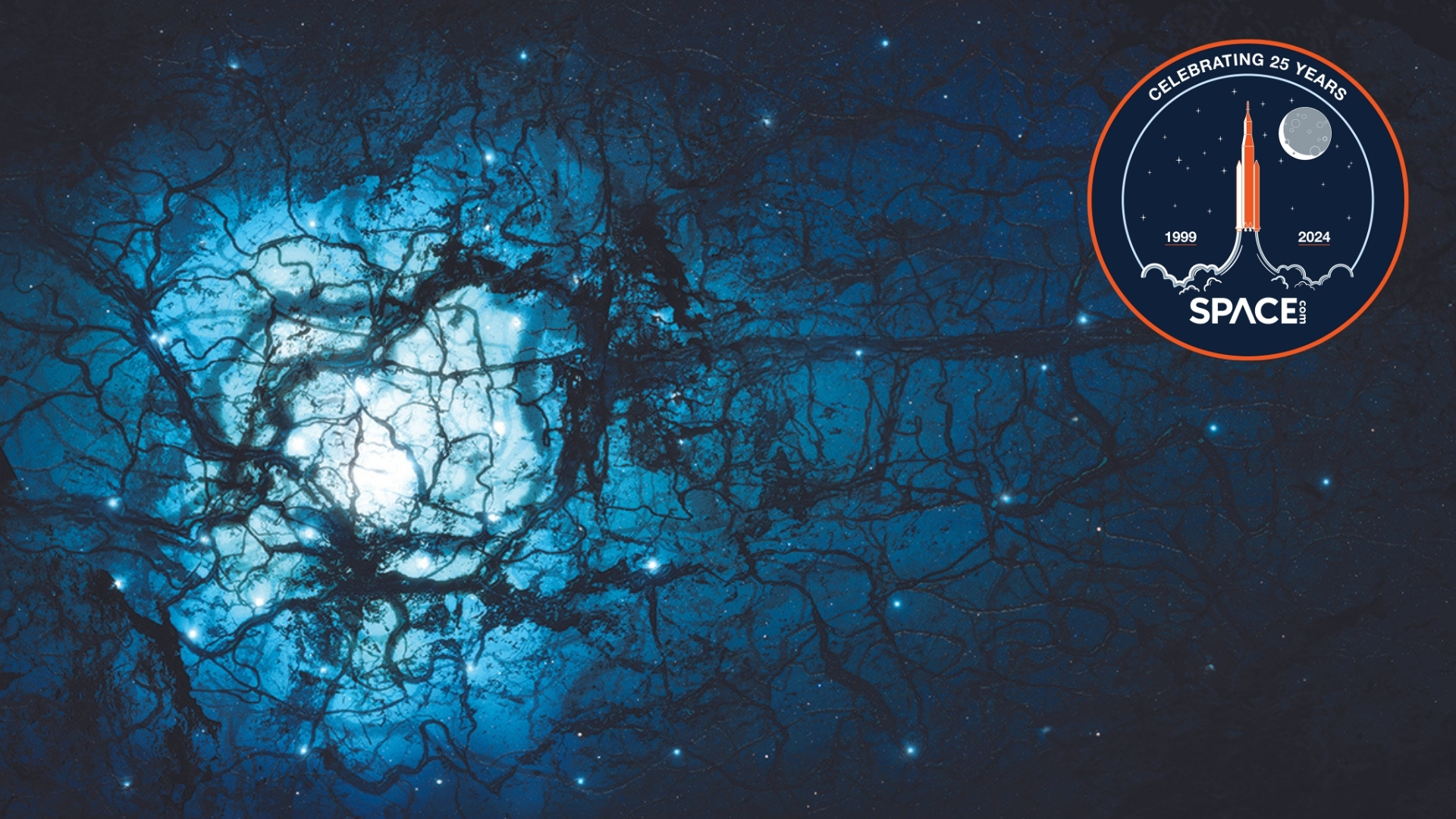
If you've been perusing our website, you've probably noticed by now that this July marks 25 years for Space.com. Fittingly, we've been celebrating this period by noting the incredible discoveries and breakthroughs in space science that have happened in the last quarter century. However, there is a dark cloud on the horizon of this celebration.
Two gatecrashers have turned up to the party to remind us that the last two and a half decades haven't only been filled with science victories. Nope, two constant and perpetual mysteries have stubbornly refused to be solved. In fact, many of the advancements made over the last 25 years regarding these elements of the universe have only served to deepen the shroud of confusion that obscures their true nature.
We are, of course, referring to dark energy and dark matter, sometimes collectively referred to as the "dark universe." But the relationship between the dark universe and Space.com actually runs deeper than our coverage of the substance's investigation. Dark energy was discovered in 1998, just a year before we were founded. We'll start there.
Check out a list of Space.com's special 25th anniversary week stories in our hub linked here!
"1999 was indeed quite important for the astronomical community as well as Space.com because it is the first full year in which we knew that the universe is not only expanding, but it is doing it at an accelerated rate," Universidad ECCI cosmologist Luz Ángela García Peñaloza told Space.com. "That is why 1999 marked a paradigm shift in the cosmological standard model. We started postulating the existence of an additional component in the cosmos's matter-energy content: dark energy."
Related: 25 years of exoplanet hunting hasn't revealed Earth 2.0 — but is that what we're looking for?
Thus, you could say that Space.com and dark energy have grown up together — and during this growth, we also charted the progress of its older dark universe sibling, dark matter, the birth of which (theoretically, at least) dates back to 1933.
"The notion of dark matter has evolved to the idea of a dark sector, with both dark matter and dark energy playing concrete and observationally established cosmological roles," Susan Gardner, a theoretical particle physicist at the University of Kentucky, told Space.com.
To understand why the dark universe is so problematic for researchers, it is apt to discuss what we do know about these aspects of the universe. One of the most important factors to consider is the utter dominance of the dark universe.
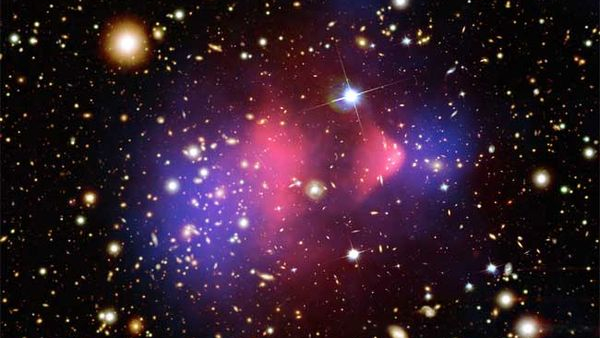
Dark matter and dark energy are big problems
We live in an epoch of the universe that is distinguished by the rule of dark energy, the force that, as Garcia Peñaloza explains, drives the accelerating expansion of the universe. Dark energy is estimated to account for between 68% and 72% of the universe’s total energy and matter contents, or "budget," thus heavily dominating both dark matter and ordinary matter.
Dark matter has less of a stranglehold on the cosmos, accounting for around 26% of the universe's total energy and matter budget. Yet, this is enough to ensure that dark matter outweighs the matter that comprises every star, every planet, every moon, every cloud of dust and gas, every human, cell phone, printer, post-it note, and cat in the cosmos — at a staggering 5 to 1 ratio.
Of course, the dominance of the dark universe just illustrates the scale of this problem; it isn’t the crux of it. The real problem is that, despite their ubiquity, dark matter and dark energy remain elusive. They seem to be extensions to the Standard Model of particle physics, which is the most detailed model we have of how all the particles in our universe interact with one another. Any extension to this model threatens its stability, and therefore our knowledge of the entire universe's physics.
Take dark matter, for instance.

The concept was first theorized by Swiss American astronomer Fritz Zwicky in 1933, when he found that the mass of all the stars in the Coma cluster of galaxies only provided 1% of the gravitational influence needed to keep these galaxies from escaping the cluster's gravitational pull. This was solidified in 1978, when astronomer Vera Rubin studied the rotation of galaxies, finding their rotational speed means the gravitational influence of visible matter in the galaxies would not be sufficient to hold them together. In other words, dark matter was posited as the glue sticking galaxies together, exerting an unseen gravitational influence to bolster what the ordinary contents of galaxies can offer.
While this influence allows dark matter's presence to be inferred through its effect on normal matter and on light, however, dark matter is effectively invisible to us. That's because it doesn’t interact with light or ordinary matter directly. It is this lack of interaction (or the existence of an extremely weak interaction that isn’t detectable by our current technology) that tells scientists dark matter can't be made up of atoms composed of protons, neutrons and electrons — all part of the "baryon" family of standard matter because these particles do interact with light, and with each other. This has prompted the search for particles beyond the Standard Model that could compose dark matter; the hunt that has consumed scientists for the past 25 years.
"I would say the leading dark matter candidates in 1999 were dark matter weakly interacting massive particles, or 'WIMPs' and axions, which were first introduced as a possible explanation for the strong CP problem [the fact that the laws of the universe seem to treat matter and antimatter differently]," Gardner said. "Both candidates are very much with us, but how they emerge from theoretical models has definitely changed with time."
She added that some dark matter particle candidates seem to have died in the last 25 years, but even these are occasionally revisited, meaning a resurrection can't be fully ruled out.
Gardner said an example of this is ultraheavy particles called charged massive particles, or "CHAMPs." These seemed to have fallen out of favor around 30 years ago in the 1990s, before dark energy was even discovered and Space.com was founded. However, CHAMPs were revisited by a team of authors as recently as 2020, so it is hard to fully dismiss their comeback as dark matter suspects.
"It seems hard to kill off particular dark matter candidates altogether," Gardner added.
One thing scientists would definitely love to kill, though, is the term "dark energy." While the "dark" prefix in both "dark matter" and "dark energy" refers to their mysterious and "invisible" nature, the former is more categorically a placeholder name for whatever this accelerating force is. While dark matter was expected by some scientists since the 1930s, around when Zwicky coined the concept, whatever dark energy is, it came as a complete surprise.
Out of nowhere!
At the beginning of the 20th century, Edwin Hubble managed to observe distant galaxies undergoing what's known as "redshift." As light travels across the universe on the way to reaching our detectors on Earth, its wavelengths sort of stretch out like rubber bands during the journey. They go from shorter, blueish wavelengths to longer, reddish ones; the longer light travels, the redder it appears. This means that if an astronomer detects light rays coming from a galaxy progressively headed toward the red end of the electromagnetic spectrum, that galaxy is probably moving away from us. So, when Hubble made this discovery, it indicated that the universe isn't static. It's actually expanding.
This took scientists of the time by surprise, as the consensus had been that the universe was static. This idea was so prevalent that when Albert Einstein devised an equation of the universe based on his theory of gravity, general relativity, he introduced a "fudge factor" called the "cosmological constant" represented by the Greek letter lambda that would counter the attractive force of gravity and keep the universe static.
Once Einstein was thoroughly convinced that Hubble was correct about the expanding universe, however, he scrapped the cosmological constant, later describing its addition as his "greatest blunder." Yet, before the 20th century was done, the expanding universe would deliver a further shock to scientists, and one that would require the cosmological constant to be rescued from the theoretical trash can.
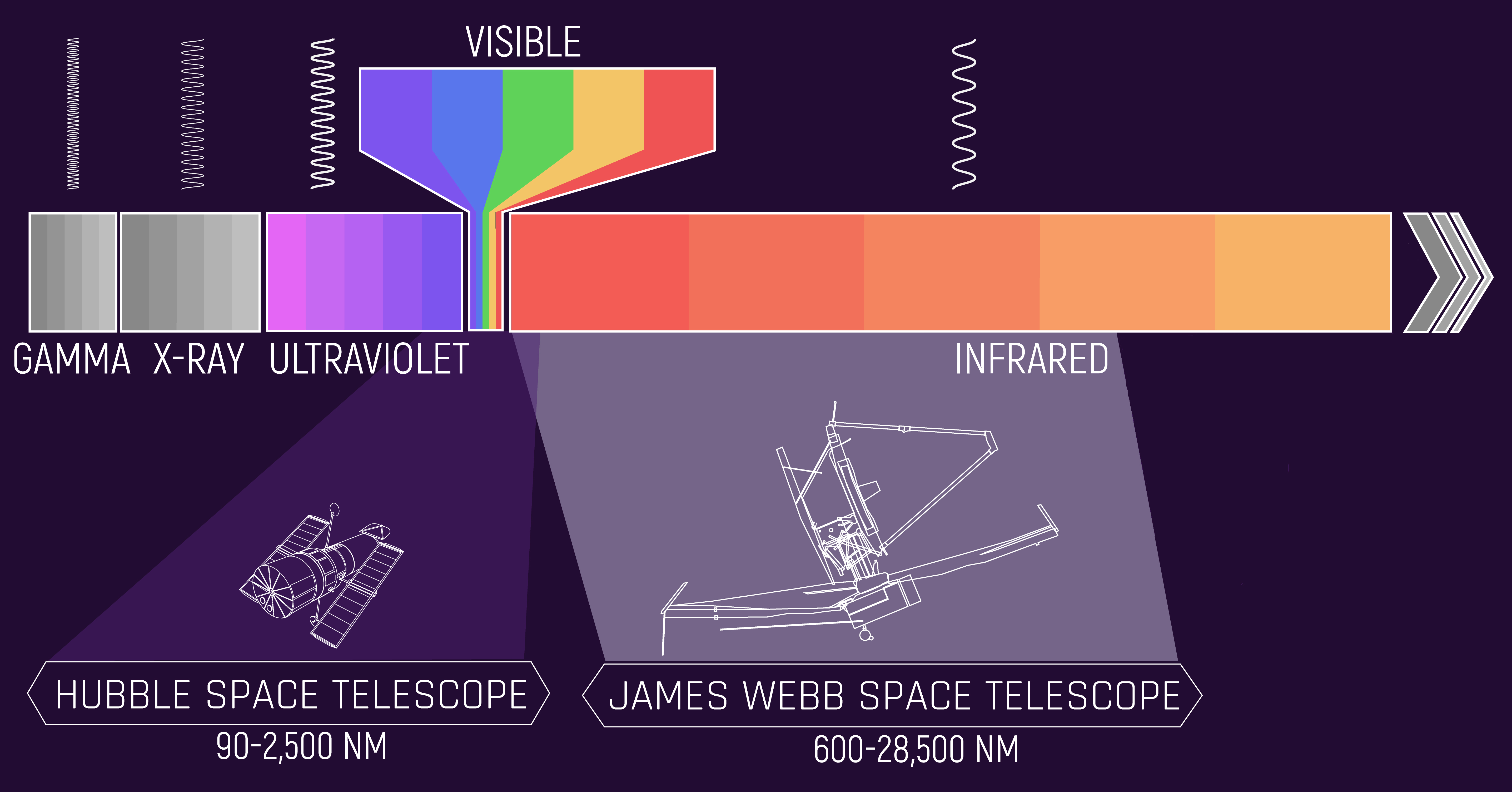
In 1998, two separate teams of astronomers making observations of distant cosmic explosions called Type Ia supernovas — which are called "standard candles" because their uniform light output can serve as buoys in the ocean of space and help scientists measure cosmic distances — found that galaxies further from us are moving away faster.
García Peñaloza explained that this discovery showed that the universe isn’t just expanding; this expansion is accelerating. Dark energy was introduced as a placeholder for whatever force is driving that acceleration.
The dark energy-driven epoch of the universe is separate and distinct from the initial period of rapid cosmic inflation that is now commonly called the "Big Bang," which saw the volume of our universe increase by a factor of 10^26 (10 followed by 25 zeroes). This rapid Big Bang-driven inflation slowed to a near halt as matter came to dominate the universe, however.
But when the universe was just under 10 billion years old, something very strange happened. The cosmos suddenly began to expand rapidly yet again, with that expansion getting faster and faster, and this acceleration continuing today. This third significant period of the universe is called the dark-energy-dominated epoch. That's what we're presently in.
To consider how strange this was to scientists, compare it to an Earth-bound analogy: pushing a child on a swing. You give the swing one big push, and you watch it reach a high point, then swing back and forth while reaching a lower and lower point with each oscillation and simultaneously slowing down. Then, just as the swing has almost stopped, suddenly and for no discernable reason, imagine it begins oscillating again. Plus, rather than reaching an initial high point and then coming to lower points with each oscillation, the swing gets higher and higher over time, and moves faster and faster. That is akin to what the universe is doing in this dark-energy-dominated epoch we are currently in.
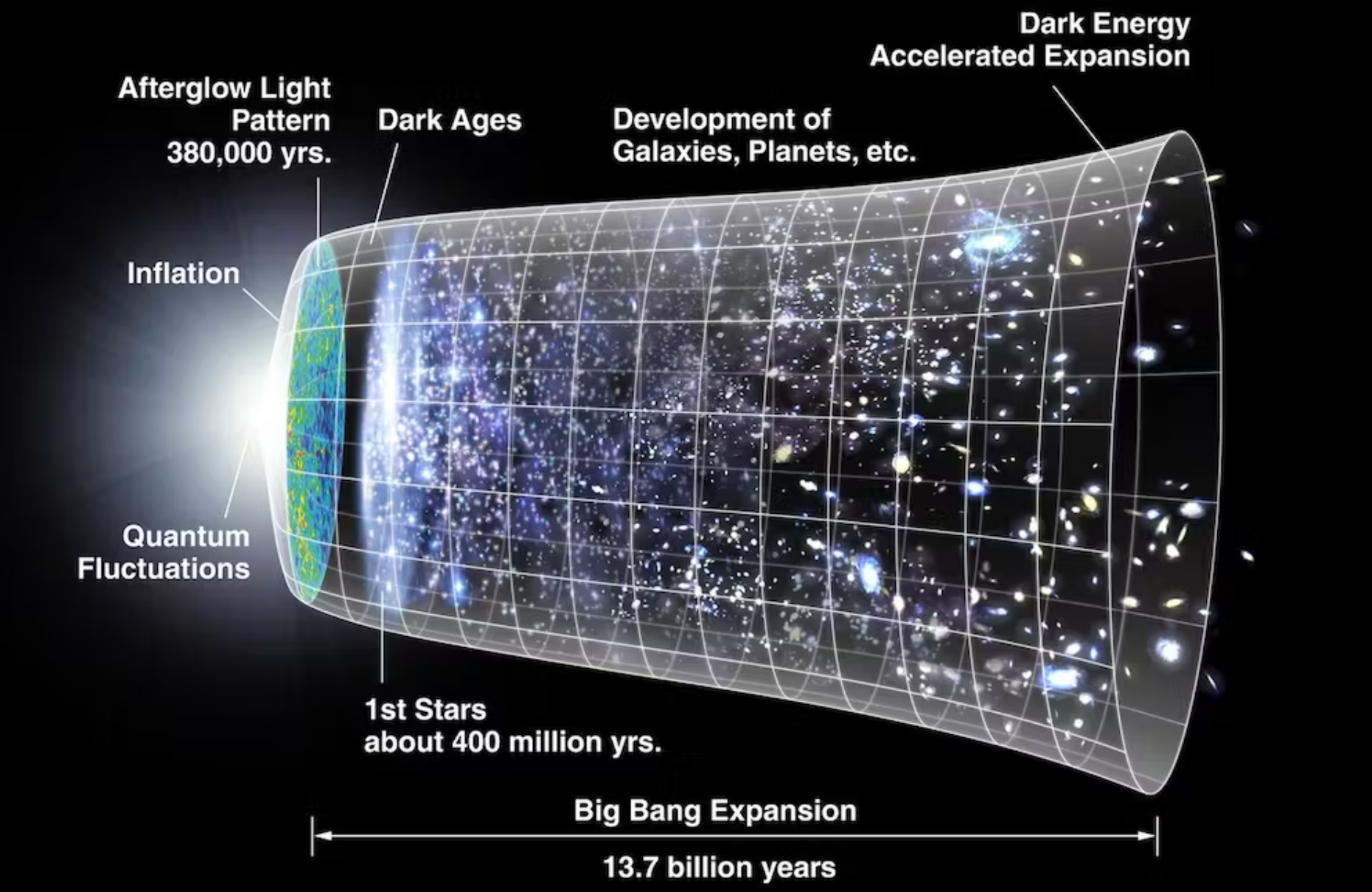
Just as you would really want to know what gave that swing the second push and how it is getting stronger, scientists desperately want to know what gave the universe a "second push" around 4 billion years ago. And just as the force driving the swing will determine the fate of the child — will they eventually fly into the bushes or into the stratosphere? — the nature of dark energy will determine the fate of the universe. Will the cosmos die as a frozen remnant with galaxies too widely separated to be seen from each other, will the very fabric of space and time "tear," or will the universe "snap back" on itself and contract?
"Although there have been multiple efforts to understand the nature of dark energy, its composition, and its manifestation in the universe — both from theoretical and observational perspectives — we know embarrassingly little about it," García Peñaloza said. "By far, the leading candidate for dark energy is the reintroduced cosmological constant [still represented with the Greek letter lambda], and it has been related to the vacuum energy of quantum fluctuations." This means virtual particles literally pop into existence in the vacuum of space. It sounds impossible, but it is indeed possible if two particles appear with equal and opposite energies and then rapidly annihilate each other. It is almost as if the universe has an overdraft facility for energy.
This accounts for dark energy in what has become the "standard model of cosmology," also known as the lambda cold dark matter model (LCDM), in which "cold" refers to dark matter particles moving slower than the speed of light. García Peñaloza explained that one alternative to the LCDM model is the wCDM model in which dark energy has a constant value, a cosmological equation of state parameter called "w," which represents the balance of the universe's pressure to its energy density.
"Dynamical dark energy models have also been shown to be compelling competitors to lambda, such as quintessence, a scalar field that evolves in time, a linear evolution of the equation of state called Chevalier-Polanski-Linder (CPL), and a very extensive list of theories that have been proposed and tested against the observables, with different physical motivations," García Peñaloza continued. "My colleagues and I have our own model of dark energy, one that evolves in the early universe as radiation and then transitions to the cosmological constant's equation of state at late times. But, I guess what matters, in this case, is what shows the observational evidence, which is increasing with new telescopes online and facilities around the world and more sophisticated simulations that now can include your favorite 'flavor' of dark energy."
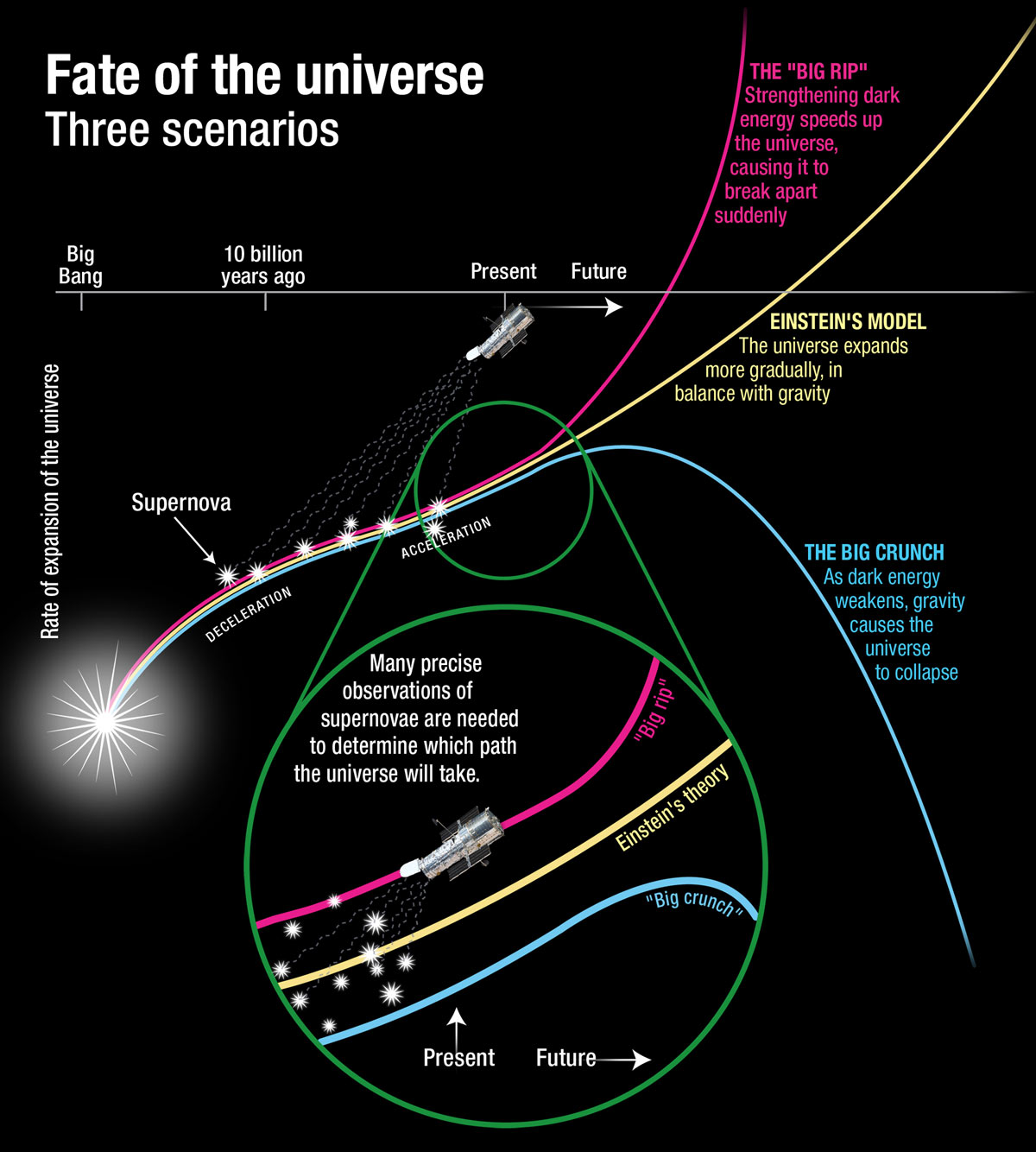
The future is bright for the dark universe
The fact that dark energy remains a frustratingly unknown quantity in the universe doesn’t mean that absolutely no progress has been made while deciphering it over the last 25 years, however. In particular, García Peñaloza thinks a development that took place this year will be particularly important for the further unraveling of this mystery.
"In my opinion, the recent year one results released by the Dark Energy Spectroscopic Instrument (DESI) collaboration have been particularly interesting because it is the first time that blinded observations disfavored the cosmological constant, but instead showed that dark energy could be varying with time," she said. "A big disclaimer here is that these are just the first year of observations of the collaboration, so the results could change in the future with a more extensive catalog of galaxies surveyed." García Peñaloza added that the James Webb Space Telescope (JWST) has also introduced tension in our current understanding of the properties of early galaxies and theoretical models that include the cosmological constant as their backbone.
"All these observations are providing us with hints that probably the Standard Model needs some adjustments," she added. "I just feel it is a very exciting moment to be working in this topic."
Additionally, NASA's Nancy Grace Roman Space Telescope and the Earth-based Vera C. Rubin Observatory will soon start exploring the universe, with both telescopes expected to deliver major dark matter and dark energy findings.
So, does Gardner think that, at some point in the next 25 years, Space.com will be reporting on a solution to the puzzle of dark matter?
"I'd like to bet 'Yes!'" she responded. "We may yet be able to detect heavy dark matter in terrestrial laboratories via its gravitational couplings, and we may be able to use gravitational wave detectors to discover or to set limits on heavy solar-system dark matter."
When asked the same question about dark energy, he was less confident.
"Tough question! I'm gonna say 'No,' she said. “For sure, we will know much more of the nature of dark energy than we know now, or maybe we will rule it out completely from the landscape. Let's stay tuned with the developments that astronomers do in these coming years, and maybe we will have the answer to this question."
You can guarantee whatever develops in the next 25 years with regards to dark matter and dark energy, Space.com will definitely be staying tuned to the dark universe, and we hope you will stay tuned to us!







